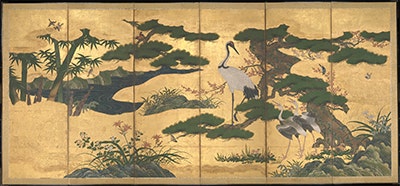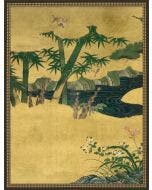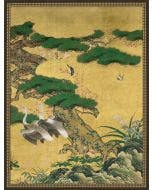Local Storage seems to be disabled in your browser.
For the best experience on our site, be sure to turn on Local Storage in your browser.
Gilded Aviary 2

This Met x Wendover Art Group design is a reproduction of an original work of art in The Metropolitan Museum of Art collection.
Our inspiration: Birds and Flowers of the Four Seasons
Japan, Momoyama period (1573–1615)
Pair of six-panel folding screens; ink, color, gold, and gold leaf
on paper; 63 1/4 in. x 11 ft. 10 in.; late 16th century
Purchase, Mrs. Jackson Burke and Mary Livingston Griggs
and Mary Griggs Burke Foundation Gifts, 1987 1987.342.1, .2
This composition of flowers shown in a seasonal progression from spring to winter, paired
with an auspicious motif of cranes, promotes longevity. The brilliant colors, strong ink outlines, gold-leaf background, and profusion of pictorial elements are typical of the style established
by Kano Motonobu (Japanese, 1476–1559), founder of the Kano school of painting, while the boldness is reminiscent of his grandson, Kano Eitoku (Japanese, 1543–1590). The exaggerated dimensions of the trees, the attempt to create space for projecting branches, and the depiction of brushwood hedges in high relief suggest that the work dates to the late 16th century. In their elegant grandeur, these screens reflect the lavish taste that prevailed in the mansions and temples of the capital during the Edo period.

This Met x Wendover Art Group design is a reproduction of an original work of art in The Metropolitan Museum of Art collection.
Our inspiration: Birds and Flowers of the Four Seasons
Japan, Momoyama period (1573–1615)
Pair of six-panel folding screens; ink, color, gold, and gold leaf
on paper; 63 1/4 in. x 11 ft. 10 in.; late 16th century
Purchase, Mrs. Jackson Burke and Mary Livingston Griggs
and Mary Griggs Burke Foundation Gifts, 1987 1987.342.1, .2
This composition of flowers shown in a seasonal progression from spring to winter, paired
with an auspicious motif of cranes, promotes longevity. The brilliant colors, strong ink outlines, gold-leaf background, and profusion of pictorial elements are typical of the style established
by Kano Motonobu (Japanese, 1476–1559), founder of the Kano school of painting, while the boldness is reminiscent of his grandson, Kano Eitoku (Japanese, 1543–1590). The exaggerated dimensions of the trees, the attempt to create space for projecting branches, and the depiction of brushwood hedges in high relief suggest that the work dates to the late 16th century. In their elegant grandeur, these screens reflect the lavish taste that prevailed in the mansions and temples of the capital during the Edo period.





